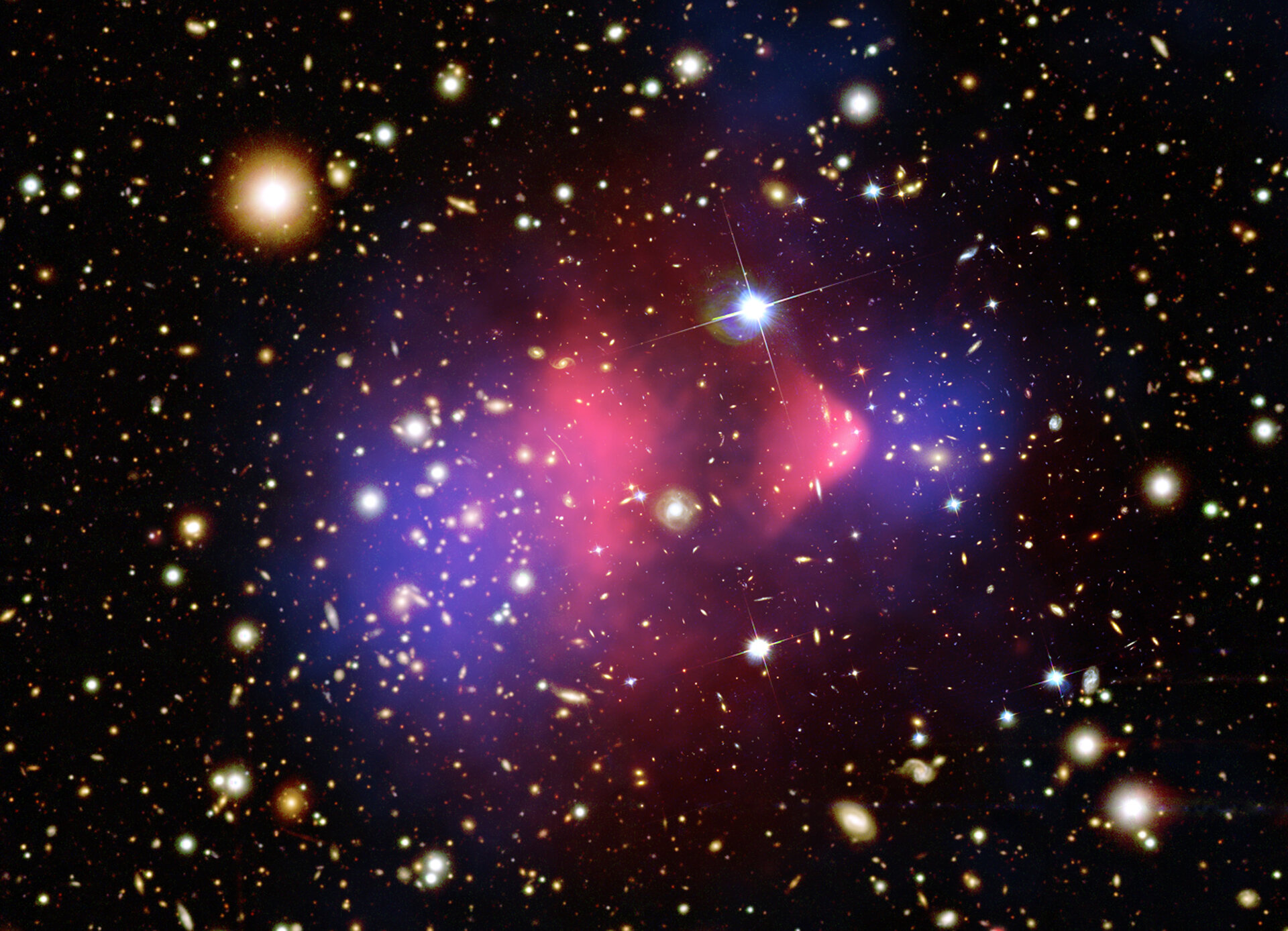The Bullet Cluster stands as one of the most remarkable and revealing cosmic events ever observed—a colossal collision between two massive galaxy clusters that has reshaped our understanding of dark matter, gravity, and the large-scale structure of the universe. Discovered through a combination of optical, X-ray, and gravitational lensing observations, this extraordinary system has become one of the most direct and compelling pieces of evidence for the existence of dark matter. Its significance extends far beyond a single astrophysical phenomenon; it represents a natural cosmic experiment that tests the fundamental laws governing matter and energy in the universe.
Understanding the Bullet Cluster requires delving into the nature of galaxy clusters, the physics of cosmic collisions, and the mysterious role of invisible mass that dominates the cosmos. The study of this system bridges observational astronomy, cosmology, particle physics, and general relativity, offering profound insights into how the universe operates on its grandest scales.
The Nature of Galaxy Clusters
Galaxy clusters are the largest gravitationally bound structures in the universe, containing hundreds or even thousands of galaxies, vast amounts of hot gas, and an even larger reservoir of dark matter. They serve as cosmic laboratories where the interactions between visible and invisible matter can be observed in detail. The combined mass of a typical galaxy cluster can reach a quadrillion times that of the Sun, distributed roughly as follows: only a few percent in stars and galaxies, about fifteen percent in hot intracluster gas, and the remaining majority—around eighty percent—in dark matter.
The galaxies themselves occupy only a small fraction of the cluster’s volume. Most of the baryonic (ordinary) matter exists in the form of a diffuse plasma at tens of millions of degrees, emitting strongly in the X-ray part of the spectrum. This gas, although invisible in optical light, dominates the luminous mass of the cluster and serves as an excellent tracer of the gravitational potential.
When two clusters collide, the dynamics of their components differ significantly. Galaxies, being relatively small and sparsely distributed, pass through each other almost unimpeded. The hot gas, however, behaves like a fluid and interacts through pressure and shock waves. Dark matter, if it exists as a collisionless component, should pass through the collision zone unaffected, interacting only through gravity. These contrasting behaviors create a unique opportunity to study the properties of each component—an opportunity that the Bullet Cluster presents in exquisite clarity.
Discovery of the Bullet Cluster
The Bullet Cluster, officially designated 1E 0657–56, was discovered as part of the Einstein Observatory Medium Sensitivity Survey in the 1980s, but its true significance became apparent only after detailed observations in the early 2000s. Located approximately 3.8 billion light-years from Earth in the constellation Carina, it consists of two galaxy clusters in the midst of a high-velocity collision.
The name “Bullet Cluster” comes from the smaller subcluster that has punched through the larger one, creating a distinct bullet-shaped shock front visible in X-ray observations. This shock front is the result of supersonic motion through the hot intracluster medium, compressing and heating the gas much like a bullet moving through the air.
The system was observed extensively using NASA’s Chandra X-ray Observatory, which provided high-resolution imaging of the hot gas, and by optical telescopes such as the Hubble Space Telescope and ground-based facilities that revealed the galaxies and gravitational lensing effects. By combining these data sets, astronomers were able to construct a detailed map of the mass distribution in the cluster, revealing a surprising and revolutionary result.
The X-ray View: Tracing the Baryonic Matter
Chandra’s X-ray images of the Bullet Cluster revealed a stunning scene of cosmic violence. The hot gas of the two colliding clusters emits brightly in X-rays, tracing the distribution of ordinary matter. The smaller subcluster, moving at a velocity of roughly 4,500 kilometers per second relative to the larger one, has created a bow-shaped shock wave where it plows through the main cluster’s plasma.
This X-ray data shows the gas being slowed and displaced by ram pressure as the two clusters interact. The gas from each cluster collides, compresses, and lags behind the galaxies and the dark matter halos that host them. The shock front, estimated to be moving at about Mach 3 relative to the sound speed in the plasma, indicates one of the fastest and most energetic collisions ever recorded in the universe.
By analyzing the X-ray emission, astronomers determined the temperature, density, and total mass of the intracluster medium. This luminous component alone, however, could not account for the gravitational effects observed in the system. Something else—something invisible—was clearly exerting a dominant gravitational influence.
The Optical and Gravitational Lensing Observations
Optical observations provided another layer of information. Using the Hubble Space Telescope and the Magellan telescopes, astronomers observed the distribution of galaxies within the Bullet Cluster. These galaxies, while spectacular in their own right, represent only a small fraction of the total mass. But more importantly, they serve as markers for the gravitational potential wells of each cluster.
To map the total mass, astronomers employed the technique of gravitational lensing, a direct consequence of Einstein’s general theory of relativity. According to general relativity, massive objects warp the fabric of spacetime, bending the paths of light from background galaxies. By measuring these distortions—known as weak lensing—scientists can infer the distribution of mass, regardless of whether that mass is luminous or dark.
When the gravitational lensing data of the Bullet Cluster was combined with the X-ray observations, the result was astonishing. The regions of strongest gravitational lensing—indicating the location of most of the mass—were not aligned with the hot X-ray-emitting gas. Instead, they coincided with the positions of the galaxies, which had moved ahead of the gas during the collision. This separation between the centers of mass and the luminous baryonic matter provided direct evidence that most of the cluster’s mass is composed of non-interacting, invisible material—dark matter.
Evidence for Dark Matter
The Bullet Cluster provided the clearest and most direct observational proof for dark matter’s existence. Before this discovery, the evidence for dark matter came largely from indirect observations such as galactic rotation curves, cosmic microwave background measurements, and large-scale structure formation. These all suggested that galaxies and clusters contain far more mass than can be accounted for by visible matter. However, none of these earlier observations could unambiguously separate dark matter from alternative explanations such as modifications to gravity.
In the Bullet Cluster, the spatial separation between the baryonic mass (traced by X-rays) and the total gravitational mass (traced by lensing) created an unmistakable signature. The gravitational field follows the galaxies and not the collisional gas. If gravity alone were modified to mimic dark matter effects, the mass distribution would still be centered on the gas, since it contains the majority of the visible mass. The fact that it is not means there must be a separate, collisionless mass component—dark matter—dominating the cluster’s gravitational field.
This observation effectively ruled out many versions of Modified Newtonian Dynamics (MOND), a popular alternative theory that sought to explain cosmic phenomena without invoking dark matter. The Bullet Cluster demonstrated that no modification of gravity alone could reproduce the observed mass-gas offset, establishing dark matter as the most viable explanation.
The Physics of the Collision
The collision between the two clusters in the Bullet Cluster is not just a spectacular visual event—it’s a complex physical process involving enormous energies and timescales. The relative velocity of approximately 4,500 km/s indicates that the subcluster passed through the main cluster around 150 million years ago, which is very recent in cosmic terms.
As the smaller cluster moves through the larger one, its galaxies pass through mostly unaffected, since galaxies are separated by vast distances compared to their sizes. The hot intracluster gas, however, experiences strong ram pressure as it encounters the gas of the larger cluster. This pressure strips the gas away from the subcluster, heating it and forming the observed shock front.
Meanwhile, the dark matter halos associated with each cluster, if truly collisionless, should move through one another with minimal interaction. This is precisely what the lensing data show: the dark matter distributions have passed through each other just as the galaxies have, leaving the collisional gas behind.
The observed dynamics of the Bullet Cluster provide important constraints on the self-interaction cross-section of dark matter. If dark matter particles interacted strongly with one another, their distribution would have been noticeably affected by the collision. The fact that they remain largely unaltered indicates that dark matter is nearly collisionless, interacting primarily through gravity and possibly weakly through other forces.
Constraints on Dark Matter Properties
From the Bullet Cluster data, astrophysicists have derived upper limits on how strongly dark matter can interact with itself. By comparing the observed separation between the dark matter and the gas, and by modeling the dynamics of the collision, researchers have constrained the self-interaction cross-section to less than about 1 cm² per gram. This value rules out many models of dark matter that predict strong self-interactions or drag forces.
These constraints are crucial for theoretical particle physics. They help narrow the range of viable dark matter candidates, from weakly interacting massive particles (WIMPs) to axions, sterile neutrinos, or other exotic particles. The Bullet Cluster does not tell us what dark matter is, but it powerfully demonstrates what it is not: it cannot be baryonic, collisional, or composed of ordinary material.
The Role of Simulations and Modeling
To fully interpret the Bullet Cluster, astrophysicists rely on detailed computer simulations that model the behavior of galaxies, gas, and dark matter during the collision. These simulations incorporate both hydrodynamics and N-body gravitational physics to reproduce the observed features.
By adjusting parameters such as collision velocity, mass ratio, impact parameter, and dark matter properties, researchers can match the observed X-ray and lensing maps with high precision. Such modeling confirms that the observed structure can only be explained if dark matter is a separate, collisionless component that dominates the total mass.
The simulations also help explore other consequences of the collision, such as the formation of turbulence in the gas, the production of high-energy particles, and the evolution of the cluster over time. They reveal that the Bullet Cluster is likely near the point of maximum separation between its components, providing a rare snapshot of a transient but highly informative stage in cluster evolution.
Challenges and Alternative Interpretations
Although the Bullet Cluster strongly supports the existence of dark matter, some researchers have explored alternative explanations. Modified gravity theories, particularly relativistic extensions of MOND such as TeVeS (Tensor-Vector-Scalar gravity), have been tested against the Bullet Cluster data. While some versions can partially reproduce the observed lensing patterns, they require fine-tuned parameters and additional unseen mass components, effectively reintroducing dark matter in another form.
Another challenge involves the statistical rarity of such high-velocity collisions. Simulations based on the standard ΛCDM (Lambda Cold Dark Matter) cosmological model suggest that collisions at the speed observed in the Bullet Cluster should be extremely rare. This has prompted discussions about whether the observed system is an outlier or whether our understanding of large-scale structure formation requires refinement.
Despite these debates, the overall scientific consensus remains that the Bullet Cluster provides strong, empirical evidence for dark matter. Subsequent discoveries of similar systems, such as the “Baby Bullet,” “El Gordo,” and “MACS J0025.4–1222,” have reinforced these conclusions, showing that the Bullet Cluster is not a unique anomaly but part of a broader cosmic pattern.
The Broader Cosmological Context
The implications of the Bullet Cluster extend beyond the system itself. Its observations fit seamlessly into the larger framework of cosmology that includes dark matter and dark energy as dominant components of the universe. In the standard ΛCDM model, dark matter forms the scaffolding upon which galaxies and clusters assemble. The Bullet Cluster provides a visual confirmation of this invisible architecture, showing dark matter acting as the gravitational backbone of structure formation.
Moreover, the system helps calibrate cosmological simulations. By comparing real-world observations with theoretical predictions, scientists refine their models of how structures grow and evolve under the influence of dark matter and cosmic expansion. The Bullet Cluster serves as both a test and a validation of these models, anchoring theoretical physics to observational reality.
Multiwavelength Observations and Continued Research
The Bullet Cluster continues to be a focus of multiwavelength research. In addition to X-ray and optical data, radio observations have detected emissions associated with relativistic electrons accelerated by the shock front. These radio halos and relics provide insight into cosmic magnetism and particle acceleration processes.
Infrared observations reveal the effects of the collision on star formation. Some galaxies within the cluster show enhanced star formation triggered by tidal forces, while others are quenched due to the stripping of gas. These observations illustrate how cluster mergers influence galactic evolution, transforming the properties of member galaxies over cosmic time.
Future missions and observatories, such as the James Webb Space Telescope and next-generation X-ray observatories like Athena, will provide even deeper and more detailed views of the Bullet Cluster. Improved gravitational lensing measurements and better mapping of dark matter substructure will refine our understanding of both cluster dynamics and dark matter physics.
The Bullet Cluster and the Nature of Dark Matter
The Bullet Cluster’s clear separation between dark and luminous matter offers a unique opportunity to constrain the fundamental properties of dark matter. It supports the notion that dark matter is non-relativistic (cold) and collisionless. These characteristics are consistent with a wide range of particle physics models, particularly those involving weakly interacting massive particles.
However, new developments in astrophysics and particle physics continue to expand the landscape of possibilities. Alternative models, such as self-interacting dark matter, fuzzy dark matter, or axion-like particles, are being explored through observations of other cluster mergers. Each new discovery adds to the puzzle, but the Bullet Cluster remains the benchmark against which all other models are tested.
Philosophical and Scientific Implications
Beyond its technical significance, the Bullet Cluster represents a profound philosophical shift in our perception of reality. It provides tangible proof that most of the matter in the universe is invisible and interacts only through gravity. This realization challenges the limits of human perception and underscores the incompleteness of our understanding of nature.
It also exemplifies the power of scientific reasoning and technology. The ability to detect and map something that cannot be seen directly, using the interplay of light, gravity, and radiation across billions of light-years, is a triumph of modern astronomy. The Bullet Cluster embodies the scientific method itself—hypothesis, observation, and verification on a cosmic scale.
Future Prospects and the Legacy of the Bullet Cluster
As observational capabilities continue to advance, the legacy of the Bullet Cluster will deepen. New cluster mergers discovered through large-scale surveys like the Vera C. Rubin Observatory’s LSST (Legacy Survey of Space and Time) will expand our sample size, allowing statistical studies of dark matter behavior. Gravitational lensing techniques will become more precise, revealing the fine-grained structure of dark matter halos.
Meanwhile, direct detection experiments on Earth, such as those searching for WIMPs or axions, continue to pursue the particle identity of dark matter. The Bullet Cluster provides crucial astrophysical constraints that guide these searches, ensuring that theoretical efforts remain grounded in observational evidence.
The system also influences our understanding of cosmic evolution. Cluster collisions like the Bullet Cluster are key drivers of structure formation, redistributing matter, heating gas, and shaping the large-scale web of the universe. Studying such events allows scientists to reconstruct the dynamic history of cosmic growth, linking the smallest subatomic interactions to the largest structures in existence.
Conclusion
The Bullet Cluster is not merely an astronomical curiosity; it is a cornerstone of modern cosmology. It presents a direct, visual confirmation that most of the universe’s mass exists in an invisible, non-collisional form—dark matter. Through its violent beauty, it reveals the underlying framework of the cosmos and provides a natural experiment for testing the laws of physics on the grandest scales.
By combining X-ray, optical, and gravitational lensing observations, scientists have peeled back the layers of this colossal collision to expose the invisible forces that shape the universe. The separation of mass and light, the shock front glowing in X-rays, and the invisible gravitational lenses bending background galaxies together form a narrative that speaks to both the power and mystery of the cosmos.
The Bullet Cluster stands as a symbol of how far human understanding has come—and how much remains to be discovered. It tells us that the universe is governed by forces beyond our senses, yet within our reach through reason and observation. In the faint glow of colliding galaxies and the silent pull of unseen matter, we glimpse the hidden architecture of reality itself.






